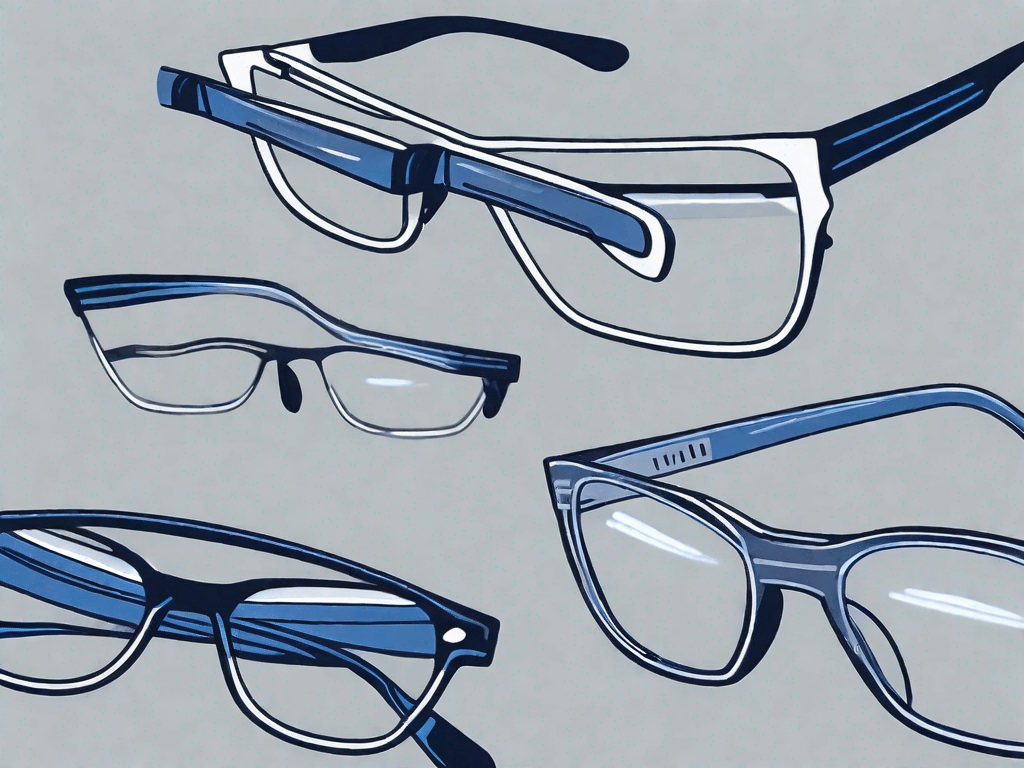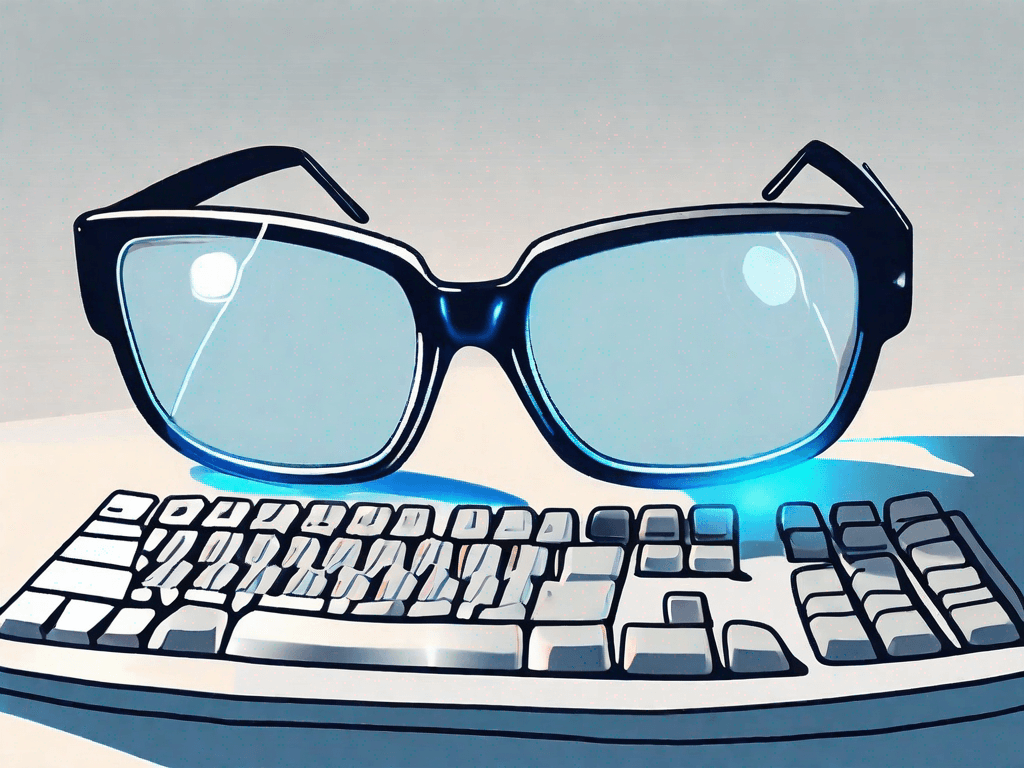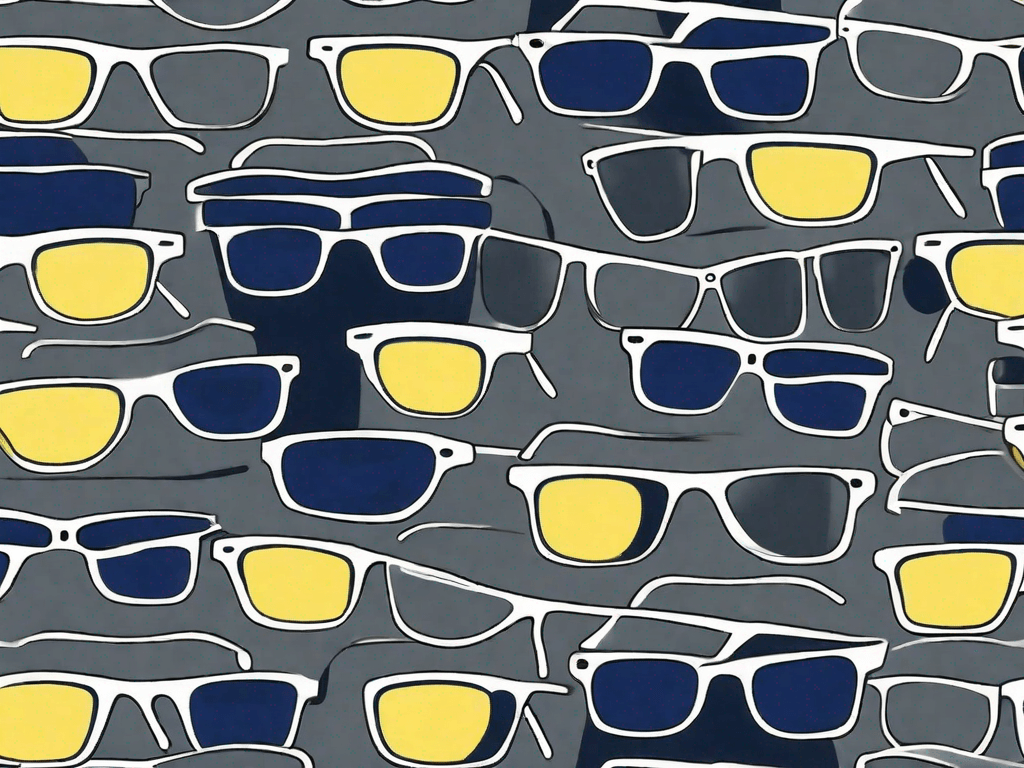Can You Put Prescription in Blue Light Glasses?
Blue light glasses have become increasingly popular as people spend more time in front of screens. These glasses are designed to block or filter out the harmful blue light emitted by electronic devices such as smartphones, tablets, and computers. But can you put prescription in blue light glasses? Let's explore the possibilities.
Understanding Blue Light Glasses
Before we delve into the question of prescription lenses, let's understand what blue light glasses are all about. Blue light glasses, also known as computer glasses, are eyewear specifically designed to reduce eye strain and protect the eyes from the potential harmful effects of blue light.
Blue light, also known as high-energy visible (HEV) light, is a type of light with a short wavelength and high energy. It is emitted by digital devices such as smartphones, tablets, computer screens, and LED lights. While blue light is naturally present in sunlight and helps regulate our sleep-wake cycle, excessive exposure to artificial blue light can have negative effects on our eyes and overall health.
Now, let's dive deeper into the world of blue light glasses and explore how they work to protect our eyes.
What are Blue Light Glasses?
Blue light glasses are eyeglasses with lenses that are tinted or have a coating to block or absorb blue light. They are typically made with special lens materials that filter out or reduce the amount of blue light that reaches our eyes.
The lenses of blue light glasses can be either yellow-tinted or have a specialized blue light filter coating. The yellow tint helps to block a portion of the blue light spectrum, while allowing other colors to pass through. On the other hand, lenses with a blue light filter coating selectively absorb the blue light waves, preventing them from reaching our eyes.
It's important to note that blue light glasses are not the same as regular sunglasses. Regular sunglasses are designed to block harmful ultraviolet (UV) rays from the sun, whereas blue light glasses specifically target blue light emitted by digital devices.
How Do Blue Light Glasses Work?
Blue light glasses work by selectively blocking or filtering out the high-energy blue light emitted by digital devices. The lenses either have a yellow tint or a specialized blue light filter coating that blocks or absorbs the blue light waves.
When we wear blue light glasses, the lenses act as a barrier, reducing the amount of blue light that enters our eyes. By limiting the exposure to blue light, these glasses help to alleviate eye strain, prevent dryness, and reduce the risk of digital eye fatigue.
Additionally, blue light glasses can also have a positive impact on our sleep quality. Exposure to blue light in the evening, especially from electronic devices, can interfere with our natural sleep-wake cycle by suppressing the production of melatonin, a hormone that regulates sleep. By wearing blue light glasses in the evening, we can minimize the disruptive effects of blue light and promote better sleep.
It's worth mentioning that while blue light glasses can be beneficial for many individuals, they may not be necessary for everyone. The need for blue light glasses depends on factors such as the amount of time spent in front of digital screens, individual sensitivity to blue light, and existing eye conditions.
In conclusion, blue light glasses are a valuable tool in our modern digital age. By reducing our exposure to blue light, these glasses help protect our eyes, alleviate eye strain, and promote better sleep. Whether you're working on a computer, scrolling through your phone, or binge-watching your favorite show, blue light glasses can be a worthwhile investment for your eye health.
The Need for Prescription Lenses
Now, let's discuss the need for prescription lenses in blue light glasses. Many individuals who spend a significant amount of time in front of screens already wear prescription glasses for vision correction. It is important to address the question of whether these individuals can combine the benefits of blue light glasses with their prescription lenses.
The Role of Prescription Lenses
Prescription lenses are designed to correct various vision problems, such as nearsightedness, farsightedness, and astigmatism. They are customized to meet the specific visual needs of individuals. When people wear prescription glasses, the lenses compensate for the refractive errors in their eyes, allowing them to see clearly.
For individuals with nearsightedness, prescription lenses are designed to focus light in a way that allows them to see distant objects more clearly. On the other hand, individuals with farsightedness require prescription lenses that help focus light properly to see nearby objects. Astigmatism, a condition where the cornea is irregularly shaped, can also be corrected with prescription lenses that compensate for the distortion in vision.
Moreover, prescription lenses are not just a one-size-fits-all solution. Each pair of prescription glasses is carefully crafted based on the individual's unique prescription. Optometrists and ophthalmologists perform comprehensive eye exams to determine the exact prescription needed for each patient. This ensures that the prescription lenses provide optimal vision correction.
Different Types of Prescription Lenses
There are different types of prescription lenses available, including single vision, bifocal, and progressive lenses. Single vision lenses correct one type of vision problem, whereas bifocal and progressive lenses correct multiple vision problems.
Single vision lenses are the most common type of prescription lenses. They are designed to correct either nearsightedness or farsightedness. These lenses have a consistent prescription throughout, providing clear vision at a specific distance.
Bifocal lenses, on the other hand, have two distinct areas on the lens. The upper part of the lens is designed for distance vision, while the lower part is for near vision. This allows individuals with presbyopia, a condition that affects near vision as people age, to have clear vision at different distances without needing to switch between multiple pairs of glasses.
Progressive lenses, also known as multifocal lenses, are similar to bifocals but offer a more seamless transition between different distances. These lenses have a gradual change in prescription, allowing individuals to see clearly at various distances, including near, intermediate, and far. Progressive lenses eliminate the visible line found in bifocals, providing a more aesthetically pleasing option for those who require multiple vision corrections.
In conclusion, prescription lenses play a crucial role in correcting vision problems and providing clear sight. With different types of prescription lenses available, individuals can find the right solution to meet their specific visual needs. Combining the benefits of blue light glasses with prescription lenses allows individuals to protect their eyes from harmful blue light while enjoying optimal vision correction.
Combining Prescription Lenses with Blue Light Glasses
Fortunately, it is possible to combine prescription lenses with blue light glasses to cater to both vision correction and blue light protection needs. To achieve this, the prescription lenses need to be incorporated into the blue light glasses.
The Process of Fitting Prescription Lenses into Blue Light Glasses
When considering putting prescription lenses in blue light glasses, it is essential to consult with an optician or eyecare professional. They can guide you through the process of fitting prescription lenses into your blue light glasses. This may involve selecting suitable frames, obtaining an up-to-date prescription, and providing your optician with the necessary information for lens customization.
During the consultation, the optician will discuss your specific vision correction needs and assess the level of blue light protection required. They will also take precise measurements to ensure that the prescription lenses fit perfectly into the chosen frames. This meticulous process is crucial to guarantee optimal vision correction and blue light filtering.
Once the frames and prescription lenses have been selected, the optician will send the information to a specialized laboratory for lens customization. The laboratory technicians will carefully craft the lenses, taking into account the prescription details and the specific blue light filtering requirements.
After the lenses have been customized, they will be fitted into the chosen frames. The optician will ensure that the prescription lenses are securely and accurately inserted, guaranteeing a comfortable and effective combination of vision correction and blue light protection.
Benefits of Prescription Blue Light Glasses
Prescription blue light glasses offer a range of benefits. By combining vision correction and blue light protection in a single pair of glasses, individuals can enjoy clear vision while minimizing their exposure to harmful blue light. This can help reduce eye strain, improve sleep quality, and protect long-term eye health.
One of the significant advantages of prescription blue light glasses is the convenience they offer. Instead of having to switch between multiple pairs of glasses, individuals can rely on a single pair to address both their vision correction needs and blue light protection requirements. This simplifies daily routines and eliminates the need for constantly swapping glasses.
Moreover, prescription blue light glasses are highly customizable. They can be tailored to meet the specific prescription requirements of each individual, ensuring optimal vision correction. Additionally, the level of blue light filtering can be adjusted based on personal preferences and the amount of blue light exposure individuals typically encounter.
By wearing prescription blue light glasses, individuals can experience enhanced visual comfort and reduced eye strain, particularly when using digital devices for extended periods. The blue light filtering properties of these glasses help to minimize the negative effects of blue light, such as dry eyes, blurred vision, and headaches.
Furthermore, the use of prescription blue light glasses can have a positive impact on sleep quality. Exposure to blue light in the evening can disrupt the natural sleep-wake cycle by suppressing the production of melatonin, a hormone that regulates sleep. By filtering out blue light, prescription blue light glasses can help promote better sleep patterns and improve overall sleep quality.
Lastly, prescription blue light glasses contribute to long-term eye health. Prolonged exposure to blue light has been linked to an increased risk of developing age-related macular degeneration (AMD) and other eye conditions. By wearing prescription blue light glasses, individuals can protect their eyes from the potential harm caused by excessive blue light exposure.
Potential Challenges and Solutions
Despite the numerous benefits, there may be some challenges when it comes to using prescription blue light glasses. Let's explore these challenges and discover potential solutions.
Possible Issues with Prescription Blue Light Glasses
One potential issue is the compatibility of certain frame styles with prescription lenses. Some frames may have limitations in terms of lens thickness or curvature, which may affect the final appearance or functionality of the glasses. For example, if you have a strong prescription, you may need thicker lenses, and not all frames can accommodate that. Additionally, individuals with high prescriptions or complex vision needs may require specialized lens technologies or higher-index lenses to ensure optimal vision correction.
Another challenge could be finding the right fit and comfort. Prescription blue light glasses need to sit properly on your face to provide the intended benefits. Ill-fitting frames can cause discomfort, pressure points, or even headaches. It's important to find frames that are not only stylish but also ergonomically designed to ensure a comfortable fit.
Furthermore, some individuals may experience difficulties adjusting to the yellow tint of blue light glasses. While the tint is designed to filter out harmful blue light, it can alter the perception of colors, especially when engaging in tasks that require color accuracy, such as graphic design or photography.
Overcoming Obstacles in Using Prescription Blue Light Glasses
To overcome these challenges, it is crucial to consult with an experienced optician or eyecare professional. They can recommend suitable frame styles and lens options based on your prescription and visual requirements. Opticians have the expertise to guide you in selecting frames that can accommodate thicker lenses or provide specialized lens technologies for complex prescriptions.
When it comes to finding the right fit, opticians can help you choose frames that are not only fashionable but also comfortable. They can assess your facial features and recommend frames that will sit properly on your nose and ears, ensuring a snug fit without any discomfort.
If you find it challenging to adjust to the yellow tint of blue light glasses, opticians can offer alternatives. Some lenses have a more subtle tint that minimizes color distortion while still providing blue light protection. Opticians can discuss these options with you and help you find the right balance between color accuracy and blue light filtering.
Remember, open communication with your optician is key. Discuss any concerns or preferences you may have, and they will be able to provide personalized solutions to meet your needs. With their guidance and expertise, you can overcome any obstacles and fully enjoy the benefits of prescription blue light glasses.
Making the Right Choice for Your Eyes
Now that we have explored the possibilities of combining prescription lenses and blue light glasses, let's dive deeper into how to make the right choice for your eyes. Making an informed decision involves considering various factors that can impact your visual health and overall comfort.
Factors to Consider When Choosing Prescription Blue Light Glasses
When choosing prescription blue light glasses, it's essential to take into account several factors that will help you find the perfect fit for your eyes. Firstly, consider your visual needs. Are you nearsighted, farsighted, or do you have astigmatism? Understanding your prescription requirements will ensure that you get the correct lenses that provide optimal vision correction.
Another crucial factor to consider is the amount of time you spend in front of screens. If you work long hours on a computer or frequently use digital devices, you may need glasses that offer a higher level of blue light protection. On the other hand, if you only use screens occasionally, you might opt for glasses with a lower blue light filter.
Personal comfort preferences should also be taken into account. Some individuals prefer lightweight frames, while others prioritize durability. Additionally, factors such as frame style, color, and fit can significantly impact your overall satisfaction with the glasses. It's important to strike a balance between optimal vision correction and effective blue light protection while considering your personal preferences.
Taking Care of Your Prescription Blue Light Glasses
Lastly, taking care of your prescription blue light glasses is crucial to ensure their longevity and effectiveness. By following a few simple steps, you can keep your glasses in excellent condition and enjoy clear vision for a long time.
It's essential to follow the care instructions provided by your optician or eyecare professional. They will guide you on how to clean the lenses properly and maintain the frames. Regularly cleaning the lenses with a microfiber cloth and lens cleaner will help remove smudges and fingerprints, ensuring optimal clarity.
Handle your glasses with care to avoid any accidental damage. Avoid placing them face down on hard surfaces or exposing them to extreme temperatures. When not in use, store your glasses in a suitable case to protect them from scratches and dust.
It is indeed possible to put prescription lenses in blue light glasses. By combining the benefits of vision correction and blue light protection, individuals can enjoy clear vision while minimizing blue light exposure.
It's important to consider factors such as your visual needs, screen time, and personal comfort preferences when choosing prescription blue light glasses. Additionally, taking proper care of your glasses will ensure their longevity and effectiveness. Consult with an optician or eyecare professional to find the best solution for your specific needs and make the right choice for your eyes.





